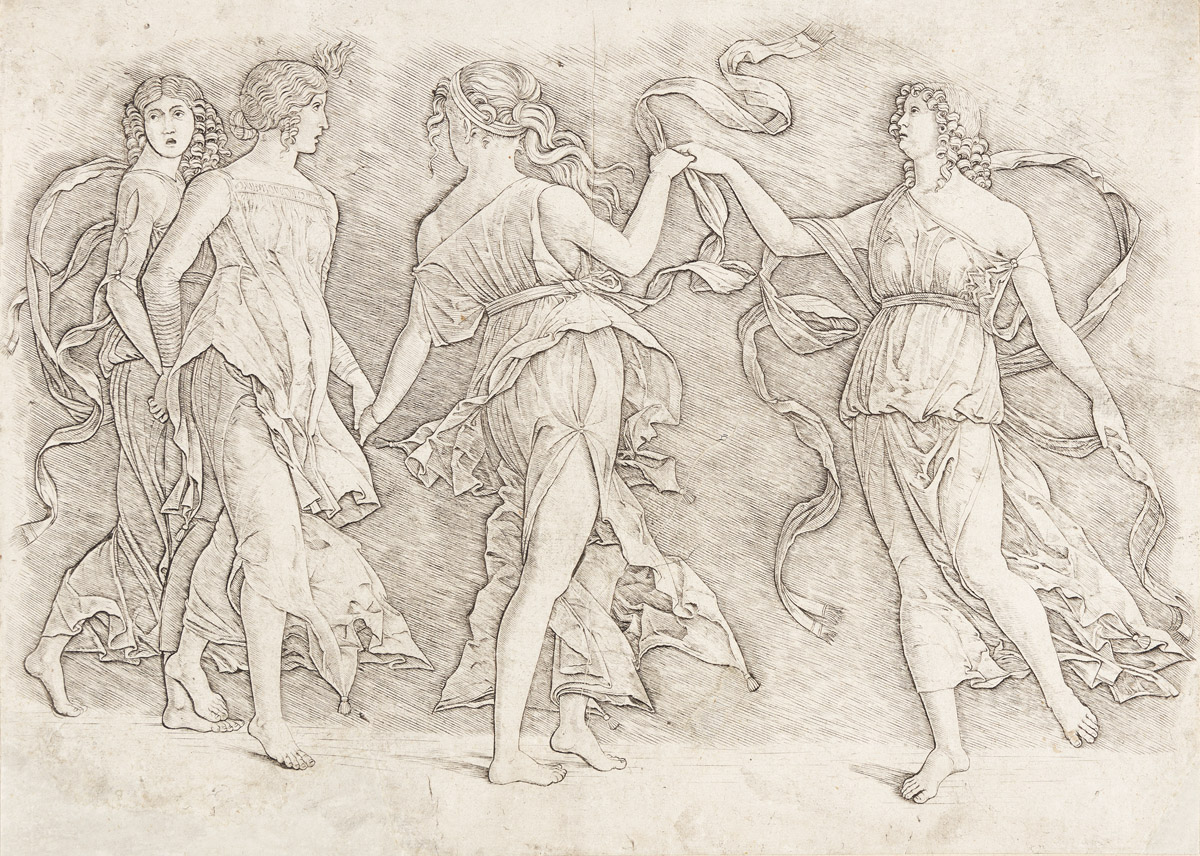Sale 2620 - Lot 24
Unsold
Estimate: $ 2,500 - $ 3,500
GIOVANNI ANTONIO DA BRESCIA (AFTER MANTEGNA)
Four Women Dancing.
Engraving, circa 1497. 247x343 mm; 9 3/4x13 1/2 inches. Small circle watermark or counter mark to an unknown watermark. A very good impression of this exceedingly scarce, early Italian Renaissance engraving.
According to Sheehan, "This engraving is based, in reverse, on four of the nine figures of women dancing, probably the Muses, in Mantegna's painting of Parnassus, completed in 1497. A number of variations from the group in the picture, principally in the poses and in the views of the figures' heads, suggest that the engraving was copied from a lost, preparatory drawing. Mantegna executed the Parnassus, as well as two other paintings, Minerva Expelling the Vices from the Grove of Virtue and Comus, for the studiolo of Isabella d'Este [in Mantua]. The Parnassus is based on the story of Venus and Mars, who were trapped in bed by a bronze net fashioned by Vulcan, her husband, and then put on display to the great amusement of the other gods," (Early Italian Engravings from the National Gallery of Art, Washington, D.C., 1973, page 228).
Giovanni Antonio da Brescia (active circa 1475-1519) worked in the circle of Andrea Mantegna (1431-1506) frequently translating his drawings and other designs into engravings. During his early career he used the initials "Z.A." to sign some twenty engravings, and until recently Zoan Andrea was regarded as a distinct printmaker; it is now realized that they are the same person, and the "Z.A." stood for Giovanni Antonio, "Zovanni" being a north Italian spelling. Around 1507 he began to use formulae such as "IO.AN.BX.", and signed some prints more fully. The real Zoan Andrea was a very obscure painter, documented as working in Mantua in the 1470s, who produced no engravings. Giovanni Antonio da Brescia began his traceable printmaking career in the circle of Mantegna, arriving in Mantua in the 1490s, and leaving around 1506, perhaps after Mantegna's death that year. He may have been relatively old and experienced as an artist in another medium when he joined the aged Mantegna. It is assumed he moved to Rome, as his later engravings depict works available to him only in that city, but the date this happened varies between different accounts. He also appears to have spent time in Florence, as one of his engravings copies a drawing by Filippino Lippi. Brescia's recently expanded œuvre comprises at least 150 engravings, including the current work. Hind 21.
Four Women Dancing.
Engraving, circa 1497. 247x343 mm; 9 3/4x13 1/2 inches. Small circle watermark or counter mark to an unknown watermark. A very good impression of this exceedingly scarce, early Italian Renaissance engraving.
According to Sheehan, "This engraving is based, in reverse, on four of the nine figures of women dancing, probably the Muses, in Mantegna's painting of Parnassus, completed in 1497. A number of variations from the group in the picture, principally in the poses and in the views of the figures' heads, suggest that the engraving was copied from a lost, preparatory drawing. Mantegna executed the Parnassus, as well as two other paintings, Minerva Expelling the Vices from the Grove of Virtue and Comus, for the studiolo of Isabella d'Este [in Mantua]. The Parnassus is based on the story of Venus and Mars, who were trapped in bed by a bronze net fashioned by Vulcan, her husband, and then put on display to the great amusement of the other gods," (Early Italian Engravings from the National Gallery of Art, Washington, D.C., 1973, page 228).
Giovanni Antonio da Brescia (active circa 1475-1519) worked in the circle of Andrea Mantegna (1431-1506) frequently translating his drawings and other designs into engravings. During his early career he used the initials "Z.A." to sign some twenty engravings, and until recently Zoan Andrea was regarded as a distinct printmaker; it is now realized that they are the same person, and the "Z.A." stood for Giovanni Antonio, "Zovanni" being a north Italian spelling. Around 1507 he began to use formulae such as "IO.AN.BX.", and signed some prints more fully. The real Zoan Andrea was a very obscure painter, documented as working in Mantua in the 1470s, who produced no engravings. Giovanni Antonio da Brescia began his traceable printmaking career in the circle of Mantegna, arriving in Mantua in the 1490s, and leaving around 1506, perhaps after Mantegna's death that year. He may have been relatively old and experienced as an artist in another medium when he joined the aged Mantegna. It is assumed he moved to Rome, as his later engravings depict works available to him only in that city, but the date this happened varies between different accounts. He also appears to have spent time in Florence, as one of his engravings copies a drawing by Filippino Lippi. Brescia's recently expanded œuvre comprises at least 150 engravings, including the current work. Hind 21.

Exhibition Hours
Exhibition Hours
Aliquam vulputate ornare congue. Vestibulum maximus, libero in placerat faucibus, risus nisl molestie massa, ut maximus metus lectus vel lorem.


